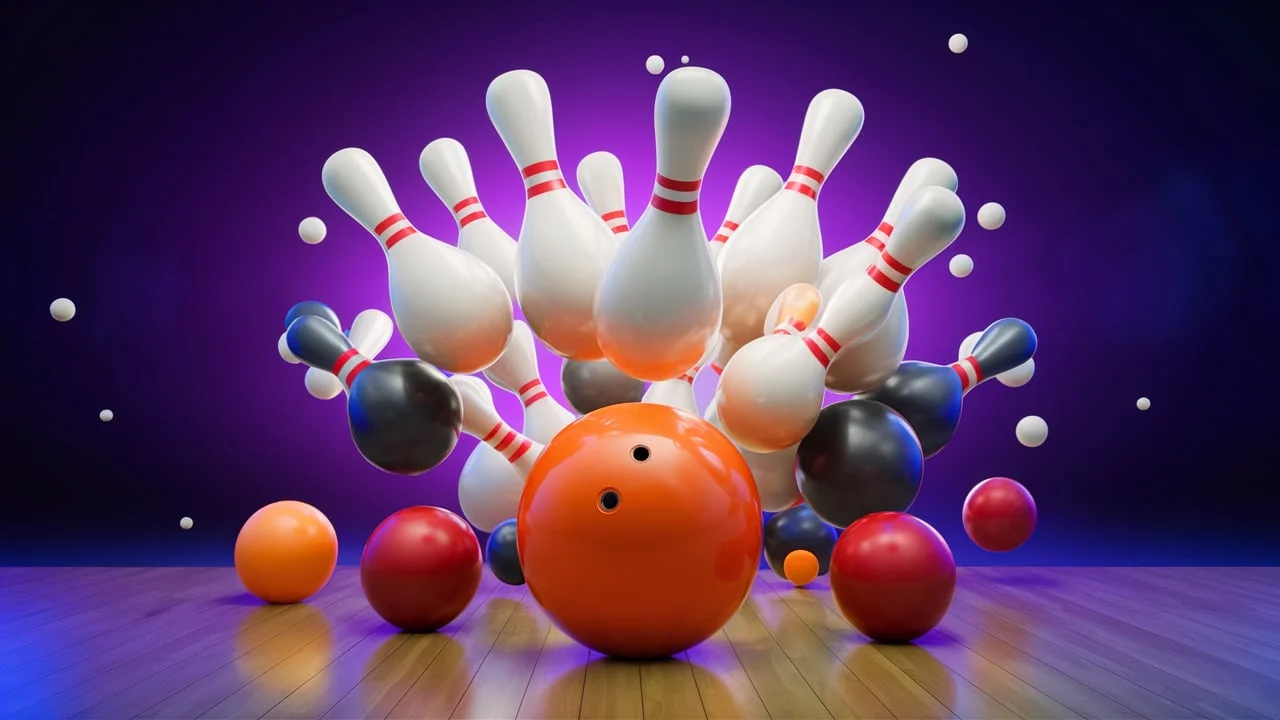Bowling is a sport enjoyed by millions around the world, whether as a competitive pursuit or a fun pastime. Let’s dive into the fascinating world of bowling with 101 surprising fun facts.
1. 🎳 History of Bowling: A Timeline of Strikes and Spares
- Bowling dates back to 3200 BC in ancient Egypt.
- The first standardized rules for bowling were established in 1895.
- King Henry VIII of England was an avid bowler.
- Bowling was banned in England in the 14th century to keep soldiers focused on archery.
- The modern ten-pin bowling originated in the United States.
- Nine-pin bowling was popular in Europe before ten-pin became dominant.
- 1930 saw the invention of the automatic pinsetter by Fred Schmidt.
- The first televised bowling event was in 1952.
- AMF (American Machine and Foundry) was crucial in commercializing bowling equipment.
- Bowling was featured as a demonstration sport in the 1988 Seoul Olympics.
2. 🎳 Anatomy of a Bowling Alley: From Pins to Lanes
- Bowling lanes are 60 feet long.
- The lane has 39 boards.
- The foul line is at the start of the lane.
- Oil patterns are applied to lanes to affect ball movement.
- Pin decks are made of durable materials to withstand impacts.
- The approach area is typically 15 feet long.
- Gutters on each side catch errant balls.
- Pinsetters are machines that reset pins after each roll.
- Bumpers can be added to lanes for novice bowlers.
- Ball returns transport the ball back to the bowler.
3. 🎳 Types of Bowling: Beyond the Ten-Pin Game
- Ten-pin bowling is the most common form.
- Nine-pin bowling is played in parts of Europe.
- Five-pin bowling is popular in Canada.
- Candlepin bowling uses thinner pins and smaller balls.
- Duckpin bowling has shorter, squatter pins.
- Lawn bowling is played outdoors on grass.
- Petanque is a French variation of lawn bowling.
- Bocce is an Italian version of lawn bowling.
- Skittles is a traditional British game similar to bowling.
- Bowlingo is a hybrid of bowling and bingo.
4. 🎳 Bowling Balls: Rolling into the Details
- Bowling balls can weigh between 6 and 16 pounds.
- Plastic balls are great for beginners.
- Urethane balls provide more hook potential.
- Reactive resin balls offer greater friction and hook.
- Particle balls have added texture for even more hook.
- Bowling balls have a core and coverstock.
- The core determines the ball’s weight distribution.
- Drilling affects how the ball reacts on the lane.
- Professional bowlers often have balls with custom grips.
- Balls are designed to hook into the 1-3 pocket for right-handed bowlers and 1-2 pocket for left-handed bowlers.
5. 🎳 Pinsetters: The Backbone of the Bowling Alley
- The first pinsetters were manual.
- Pin boys were hired to reset pins before automation.
- AMF introduced the automatic pinsetter in the 1950s.
- Pinsetters use a sweep bar to clear fallen pins.
- Grippers pick up and reset the pins.
- Modern pinsetters can handle over 100 cycles per hour.
- They use sensors to detect pin positions.
- Pin decks are calibrated for precise pin placement.
- Pinsetters are maintained by mechanics.
- They are a crucial part of a smooth bowling experience.
6. 🎳 Scoring in Bowling: From Gutter Balls to Perfect Games
- A perfect game is 300 points.
- Strikes score 10 points plus the next two rolls.
- Spares score 10 points plus the next roll.
- An open frame scores just the pins knocked down.
- Turkey is three strikes in a row.
- Four strikes in a row is a four-bagger or hambone.
- Split leaves two or more pins apart.
- Gutter balls score zero.
- The tenth frame allows for up to three rolls.
- Handicap scoring adjusts for skill differences.
7. 🎳 Bowling Techniques: Mastering the Game
- Stance is crucial for balance.
- Approach involves timing and steps.
- Release affects the ball’s path.
- Follow-through ensures accuracy.
- Hook increases strike potential.
- Straight ball is best for beginners.
- Spare shooting requires precision.
- Lofting can overcome lane conditions.
- Spin adds control and power.
- Adjustments are necessary for different oil patterns.
8. 🎳 Famous Bowling Alleys: Lanes of Legends
- Bowlero Times Square in New York City.
- Lucky Strike Hollywood in Los Angeles.
- Thunderbowl Lanes in Allen Park, Michigan.
- National Bowling Stadium in Reno, Nevada.
- Red Rock Lanes in Las Vegas.
- South Point Bowling Center in Las Vegas.
- Sun Valley Lanes in Lincoln, Nebraska.
- Splitsville in Orlando, Florida.
- Bowlmor Chelsea Piers in New York City.
- AMF Bowling Co. locations across the U.S.
9. 🎳 Bowling Records: Strikes in the Record Books
- The highest recorded score in one game is 300.
- Tommy Gollick bowled the most strikes in an hour: 50.
- Glenn Allison bowled the first sanctioned 900 series.
- The longest marathon ten-pin bowling lasted 134 hours.
- The largest bowling tournament is the USBC Open Championships.
- The heaviest bowling ball ever used was 23 pounds.
- The fastest bowling speed recorded is 100.2 km/h.
- The largest bowling center has 116 lanes (Inazawa Grand Bowl, Japan).
- Maja Plesnik holds the record for most strikes in 24 hours: 1,194.
- Walter Ray Williams Jr. has the most career PBA titles: 47.
10. 🎳 Bowling Culture: From Pop Culture to Traditions
- Bowling alleys often feature in movies and TV shows.
- The Big Lebowski is a cult classic centered around bowling.
- Fred Flintstone popularized bowling on The Flintstones.
- Bowling shirts became a fashion trend in the 1950s.
- Cosmic bowling features glow-in-the-dark lanes.
- Bowling leagues foster a sense of community.
- Bowling for Soup is a band named after the sport.
- Bowling parties are popular for birthdays and corporate events.
- Many bowling alleys have arcades and dining options.
- Bowling alleys have evolved to become entertainment hubs.
11. 🎳 Bowling Shoes: Slipping into the Details
- Bowling shoes have a sliding sole.
- Rental shoes are available at most alleys.
- Professional bowlers have custom-fitted shoes.
- Shoes have different soles for left and right feet.
- Slide soles allow for a smooth approach.
- Traction soles provide stability.
- Shoes must be cleaned regularly.
- Velcro straps are common in rental shoes.
- Some shoes have interchangeable soles.
- Bowling socks can enhance comfort and performance.
12. 🎳 Bowling Etiquette: Striking the Right Note
- Wait for your turn to bowl.
- Don’t step onto the lane with street shoes.
- Respect other bowlers’ space.
- Avoid distractions while others are bowling.
- Return house balls to the rack after use.
- Keep food and drinks away from the lanes.
- Congratulate other bowlers’ good rolls.
- Don’t linger on the approach.
- Be courteous to bowling alley staff.
- Follow the rules and guidelines of the alley.
13. 🎳 Bowling Equipment: Beyond the Ball
- Wrist supports can enhance control.
- Bowling bags protect and transport gear.
- Towels help keep balls clean.
- Grip sacks improve hand dryness.
- Rosin bags provide a better grip.
- Shoe covers protect bowling shoes.
- Finger inserts offer a snug fit.
- Tape can adjust the feel of the ball.
- Ball polish maintains surface texture.
- Ball spinner for detailed cleaning and polishing.
14. 🎳 Bowling Terminology: Speak Like a Pro
- Strike: Knocking down all pins on the first roll.
- Spare: Knocking down all remaining pins on the second roll.
- Turkey: Three consecutive strikes.
- Hambone: Four consecutive strikes.
- Gutter ball: Ball falls into the gutter.
- Split: Pins left standing with a gap between them.
- Hook: Ball curves towards the pins.
- Perfect game: Scoring 300 points.
- Frame: One of ten segments in a game.
- Pocket: Ideal area for a strike (1-3 for right-handers, 1-2 for left-handers).
15. 🎳 Bowling Leagues: Competing for Glory
- Leagues can be casual or competitive.
- Teams are usually made up of four to five members.
- Handicap systems level the playing field.
- Leagues run in seasons of 8-12 weeks.
- Prize funds are common in competitive leagues.
- Leagues foster community and camaraderie.
- Scotch doubles involve alternating frames between partners.
- Baker system has teammates alternating rolls within a single game.
- Position rounds determine final standings.
- Awards and trophies are often given at the end of the season.
16. 🎳 Bowling Tournaments: Striking It Big
- The PBA Tour is the premier professional league.
- USBC Open Championships is the largest amateur event.
- PWBA showcases top women bowlers.
- Junior Gold Championships are for youth bowlers.
- Regional tournaments offer local competition.
- Brackets format pits bowlers in head-to-head matchups.
- Qualifying rounds determine who advances.
- Step-ladder finals are common in professional events.
- Cash prizes are a major incentive.
- International competitions bring together bowlers from around the world.
17. 🎳 Bowling Strategies: Aiming for Consistency
- Analyze the oil pattern on the lanes.
- Adjust your starting position as needed.
- Focus on hitting the pocket consistently.
- Use different balls for strikes and spares.
- Develop a pre-shot routine.
- Practice spare conversions.
- Watch other bowlers for lane insights.
- Make minor adjustments frequently.
- Work on your mental game.
- Stay calm and focused under pressure.
18. 🎳 Bowling Trivia: Fun Facts to Share
- The maximum weight for a bowling ball is 16 pounds.
- Bowling is the number one participation sport in the U.S.
- The first bowling balls were made of wood.
- A perfect series is three consecutive 300 games.
- The average league bowler scores around 170.
- The term “bowling alley” originated in the 19th century.
- Bowling balls were first made of rubber in the 1900s.
- The largest bowling center in the world is in Japan.
- “Turkey” came into use because it was once a common prize for strikes.
- Professional bowlers can earn six-figure salaries.
19. 🎳 Bowling Safety: Keeping it Fun and Safe
- Always wear bowling shoes.
- Use the correct weight ball for your strength.
- Avoid walking onto the oiled part of the lane.
- Warm-up before bowling.
- Stretch your arms and legs.
- Use proper lifting techniques for balls.
- Stay hydrated during play.
- Report spills or hazards to staff.
- Follow lane rules and guidelines.
- Be mindful of others around you.
20. 🎳 Bowling Puns and Jokes: A Good Laugh on the Lanes
- Why did the bowler bring an extra pair of pants? In case he got a split.
- What do bowlers do when they need help? They spare a moment.
- How do bowlers stay calm? They keep their cool.
- What did the bowler do with the bowling ball? He threw it down the alley.
- Why was the bowling alley so quiet? You could hear a pin drop.
- How does a bowler always get a strike? By rolling with it.
- Why are bowlers so good at math? They always know the score.
- What did the bowling ball say to the pins? I’m on a roll!
- Why was the bowler a great cook? He always knew how to serve up strikes.
- What’s a bowler’s favorite type of music? Rock and bowl!
Conclusion: Wrapping Up the Bowling Fun 🎳
Bowling is a sport rich in history, culture, and fun facts. Whether you’re a casual bowler or a seasoned pro, there’s always something new to learn about this timeless game. From understanding the nuances of the lanes and equipment to mastering the perfect strike, bowling offers endless opportunities for enjoyment and improvement. So next time you hit the lanes, remember these fun facts and share them with your fellow bowlers. You might just strike up an interesting conversation!

Dariel Campbell is the creator behind laughter.com, where humor knows no bounds. With a passion for bringing joy through laughter, Dariel curates hilarious content that brightens your day.










